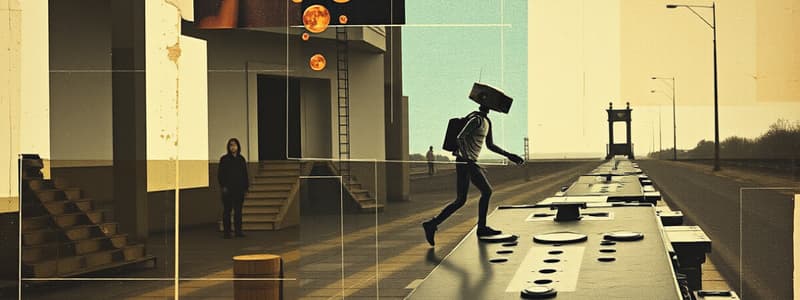Podcast
Questions and Answers
What happens when the robot encounters an obstacle while moving toward the goal configuration?
What happens when the robot encounters an obstacle while moving toward the goal configuration?
- The robot stops and waits for a signal.
- The robot continues moving straight toward the goal without changing direction.
- The robot will turn randomly or predefined left/right and follow the obstacle boundaries. (correct)
- The robot will reverse and seek a new path.
Why is convergence not guaranteed when the robot follows an obstacle?
Why is convergence not guaranteed when the robot follows an obstacle?
- The robot may choose motion directions that do not lead effectively around the obstacle. (correct)
- Obstacles can shift unpredictably while the robot is moving.
- The robot's sensors can fail, leading to misdirection.
- The robot is programmed to follow obstacles indefinitely.
In which dimensional spaces is the obstacle boundary's tangent space one-dimensional?
In which dimensional spaces is the obstacle boundary's tangent space one-dimensional?
- In zero-dimensional spaces.
- In one-dimensional C-spaces.
- In three-dimensional and higher-dimensional C-spaces.
- In two-dimensional C-spaces. (correct)
What technique can be employed in three-dimensional or higher-dimensional C-spaces to navigate around obstacles?
What technique can be employed in three-dimensional or higher-dimensional C-spaces to navigate around obstacles?
What is the expected outcome when a robot follows the algorithm described while navigating around obstacles?
What is the expected outcome when a robot follows the algorithm described while navigating around obstacles?
What action does the BUG1 algorithm take when the robot meets an obstacle?
What action does the BUG1 algorithm take when the robot meets an obstacle?
After encircling the obstacle, what does the robot do next in the BUG1 algorithm?
After encircling the obstacle, what does the robot do next in the BUG1 algorithm?
What is the overall goal of the BUG1 algorithm while navigating around obstacles?
What is the overall goal of the BUG1 algorithm while navigating around obstacles?
Which statement best describes the behavior of the robot when it is in the interior of $C_{free}$?
Which statement best describes the behavior of the robot when it is in the interior of $C_{free}$?
What denotes the configuration where the robot meets an obstacle in the BUG1 algorithm?
What denotes the configuration where the robot meets an obstacle in the BUG1 algorithm?
Flashcards are hidden until you start studying
Study Notes
BUGO (Reads Bug-Zero) Overview
- Motion initiates in the configuration space, CfreeC_{free}Cfree, directed towards the goal configuration, cgc_gcg.
- When encountering an obstacle, the robot adapts its path to navigate along the obstacle's boundaries.
- Turning direction (left or right) during obstacle navigation may be random or predefined, potentially impacting efficiency.
- Motion resumes towards cgc_gcg in a straight line once the robot no longer intersects with the obstacle.
- The algorithm does not guarantee convergence to the goal due to the arbitrary nature of the turning direction.
Outcomes of the Algorithm
- Potential results vary; effective navigation can lead to a detour that successfully avoids obstacles, depicted in Figure 1.11a.
- Conversely, an inefficient path may result in failure to reach the goal, as illustrated in Figure 1.11b.
Dimensionality Considerations
- The algorithm is straightforward in two-dimensional space where obstacle boundaries form a one-dimensional tangent space.
- The robot faces a binary choice—turning either left or right—when navigating obstacles in a planar space.
- In three-dimensional or higher-dimensional configuration spaces, the directional choices are infinite, complicating obstacle avoidance.
- To tackle this complexity, a generalized gradient descent method can be employed for effective navigation along the boundaries of obstacles.
BUG1 Algorithm Overview
- Operates effectively when the robot is within the free configuration space, denoted as CfreeC_{free}Cfree.
- When encountering an obstacle, the robot's configuration is referred to as CobsC_{obs}Cobs.
- The algorithm involves encircling the obstacle to identify the closest position to the goal configuration (cgc_gcg).
- After encircling, the robot returns to the nearest point to cgc_gcg.
- The robot then moves directly towards cgc_gcg in a straight trajectory.
Studying That Suits You
Use AI to generate personalized quizzes and flashcards to suit your learning preferences.




